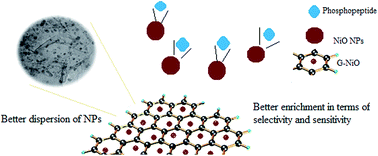Metal oxide based nanocomposites are applied in phosphoproteomics for enrichment through the surface hydroxyl groups of metal oxides, though the role of the metal is rarely described. Using graphene as a template after modification with nickel oxide, a nanocomposite with an increased surface area is fabricated and applied to phosphopeptides. Characterisation shows a narrow size distribution of 15–20 nm, BET surface area of 179.70 m2 g−1 and a pore volume of 0.44 cm3 g−1. The graphene possesses well distributed NiO nanoparticles showing selectivity up to 1000 folds of complexity with a sensitivity as low as 1 femtomole. The G–NiO nanocomposite shows a higher selectivity towards phosphopeptides compared to TiO2, ZrO2 and NiO nanoparticles. The enrichment with the G–NiO nanocomposite is tested for biological samples like egg yolk, non-fat milk and human serum. Phosphopeptides having phosphorylations of up to 6 phosphate groups, derived from phosvitin and lipovitellin, are enriched in the egg yolk digest. Phosphopeptides characteristic of casein variants are enriched in the non-fat milk digest with a recovery of αS1 21.9%, αS2 30% and β-casein 20%. Phosphorylated proteins are identified in human serum through the enrichment of phosphopeptides.

